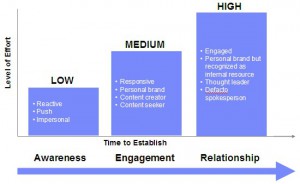This past May, Tony Pearson had a problem. He was visiting with a group of customers in Australia — nearly 8,000 miles away from his home base at the IBM System Storage Executive Briefing Center in Arizona — and needed to know if the IBM XIV Storage System would work in a particular competitive environment. And so the master inventor and senior managing consultant posted his question on Twitter and waited.
Within 30 minutes, he received return tweets from the two non-IBM hardware manufacturers involved letting him know that they both support the proposed configuration.
“I got my answer without even knowing who to call or who works in those companies,” says Tony. “I just put it out there saying: I have this question. Does anybody have an answer?”
Tony’s story is just one more example of how he’s been able to use social media to benefit IBM and build his personal brand as a system storage expert and go-to guy.
How it all began
Back in 2006, Tony was asked to create a set of podcasts to explain and promote IBM’s renaming of its disk and tape products under the IBM System Storage product line. Thinking his voice was unsuitable for a podcast, he decided instead to blog about the changes. A year later, when he was transferred to IBM’s Executive Briefing Center, he continued to publish his blog, changing its content and readership to support his new organization and job responsibilities.
Tony’s philosophy on blogging stems from a book he read early on titled Naked Conversations by Robert Scoble and Shel Israel. “They had a very crisp definition of a blog. It’s the unedited voice of the individual,” he says.
So what does he talk about? “I talk about new announcements. I talk about how to use the products. I don’t talk about conversations I have with clients, but I might say: ‘These questions come up fairly frequently at briefings … so I thought I’d clarify this position or how IBM feels about this.’”
And every now and then, he’ll write about something personal — a vacation he’s taken or his volunteer efforts.
Tony believes his blog also helps open up IBM to the outside world. “IBM in the past has been seen as this impenetrable fortress,” he explains. “And I tell everybody … if you have a question about storage and you don’t know who to ask contact me and I’ll find the right person.”
His passion and commitment to his “Inside System Storage” blog have helped make it one of the most active blogs on IBM developerWorks. “People know who I am and they can trust what I say versus someone else who they’ve never seen or heard from before,” he adds.
Tips for success
Tony likes the progressive, open approach IBM has taken regarding the use of social media by employees. “One of the things that IBM did well is develop a very robust, simple-to-follow set of social computing guidelines,” he says. He cites “don’t pick fights” and “identify who you are” as two of the guidelines that can help people starting out avoid common mistakes.
And he encourages all of his colleagues to find their voice in the blogosphere, express their opinions on Twitter, share their presentations on SlideShare.net or post photos, graphs and diagrams on Flickr.com. His recipe for social media success rests on four essential ingredients:
- Stick to your expertise. “I saw a great quote that I used in one of my blog posts that said that the food in museums was as bad as the murals in restaurants. It was a good reminder that you should focus on what you know.”
- Do your homework. “People should read before they write. You’re more credible when you can say ‘I’ve read everyone else’s writing first, and here’s my opinion’ as opposed to adding little or no value to the conversation.”
- Devote the time. “There’s a lot of work to create a blog post … gather the research and do all the stuff so you make a complete quality post. It’s not going to happen with10 minutes a day.”
- Keep active. “One person told me a great thing: blogging is like jogging. If you don’t jog daily or weekly, and only jog every now and then, it’s not going to be of any value.”
He also warns people to avoid perfectionism when blogging. “I think people are worried … that they’re going to say something that makes them look like they’re not the experts that they claim to be,” says Tony. “Just like in real life, you can edit the blog and say ‘I made a mistake. This is what I meant to say.’”


